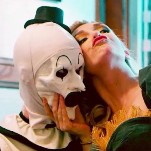I Watched The Bedford Stop and My Whole Life Fell Apart
EntertainmentWhat is reality television in 2015? Depending on your definition of “reality” and “television,” that’s a tough question to answer. Is reality television actual reality in that it’s exactly like real life, only filmed? Or is it merely reality in that it’s produced in the distinct, Laguna Beach-like style that we’ve known as “reality television” for over a decade? Furthermore, is a reality television show exclusive to YouTube, still television at all? Or do we watch so much “television” on screens other than our actual televisions that the distinction is now unnecessary?
These are the questions I had while watching the new YouTube series The Bedford Stop this afternoon, but they are not the only ones. Because watching The Bedford Stop made me second guess more than just the state of reality television, it made me reconsider my own reality. Our reality. After finishing its pilot episode, I questioned my own existence as a human being who lives in New York among other human beings who are capable of creating, filming, starring in, editing, and uploading something as simultaneously miserable and captivating as The Bedford Stop. Are they really here? Are they really real? Are they living and breathing in my reality? And, more importantly, am I?
The Bedford Stop bills itself as “a reality show about Brooklyn girls avoiding reality,” which is hypnotic enough. A reality show about Brooklyn girls avoiding reality. A reality show about Brooklyn girls avoiding reality. Is this art? Has Banksy chosen YouTube as his next canvas?
More questions.
The Bedford Stop’s protagonists are all young women in their early- to mid-twenties who live in the northeast side of Brooklyn’s Williamsburg neighborhood, just off the Bedford stop of the L train. The overcrowded and ever-worsening neighborhood of Williamsburg actually exists. The terrible restaurants and bars and venues they visit actually exist. That subway stop, one of the most miserable in the entire MTA system, actually exists.
But what about its alleged inhabitants—the stars of The Bedford Stop? Do they exist? Do women with names like “melissa” and “olena” and “sarah” who wander around their dark apartments while mumbling existential questions like, “Who are you, me?” live and breathe in the same city as I and millions of others, or are they fictional characters created and performed for a reality television show that isn’t on actual television?
Watching the show’s 16-minute, 55-second pilot (entitled “Tinder Me Softly”) I found myself dipping in and out of a haze, unable to get a firm grasp on who these people were, why they were friends, how they afforded their empty apartments, and whether or not I believed they actually existed in the same universe as I do. None of them, despite being on a reality show, feel real.
Then there’s Olena, whose subplot in the pilot revolves around her desperate need for a professionally photographed Tinder headshot that she can also use as a photo on her LinkedIn profile. Is that a real problem people have, and is this website art?
-

-

-

-

-

-

-

-

-

-

-

-

-

-

-

-

-

-

-

-

-

-

-

-

-

-

-

-

-

-

-

-

-

-

-

-

-

-

-

-








































